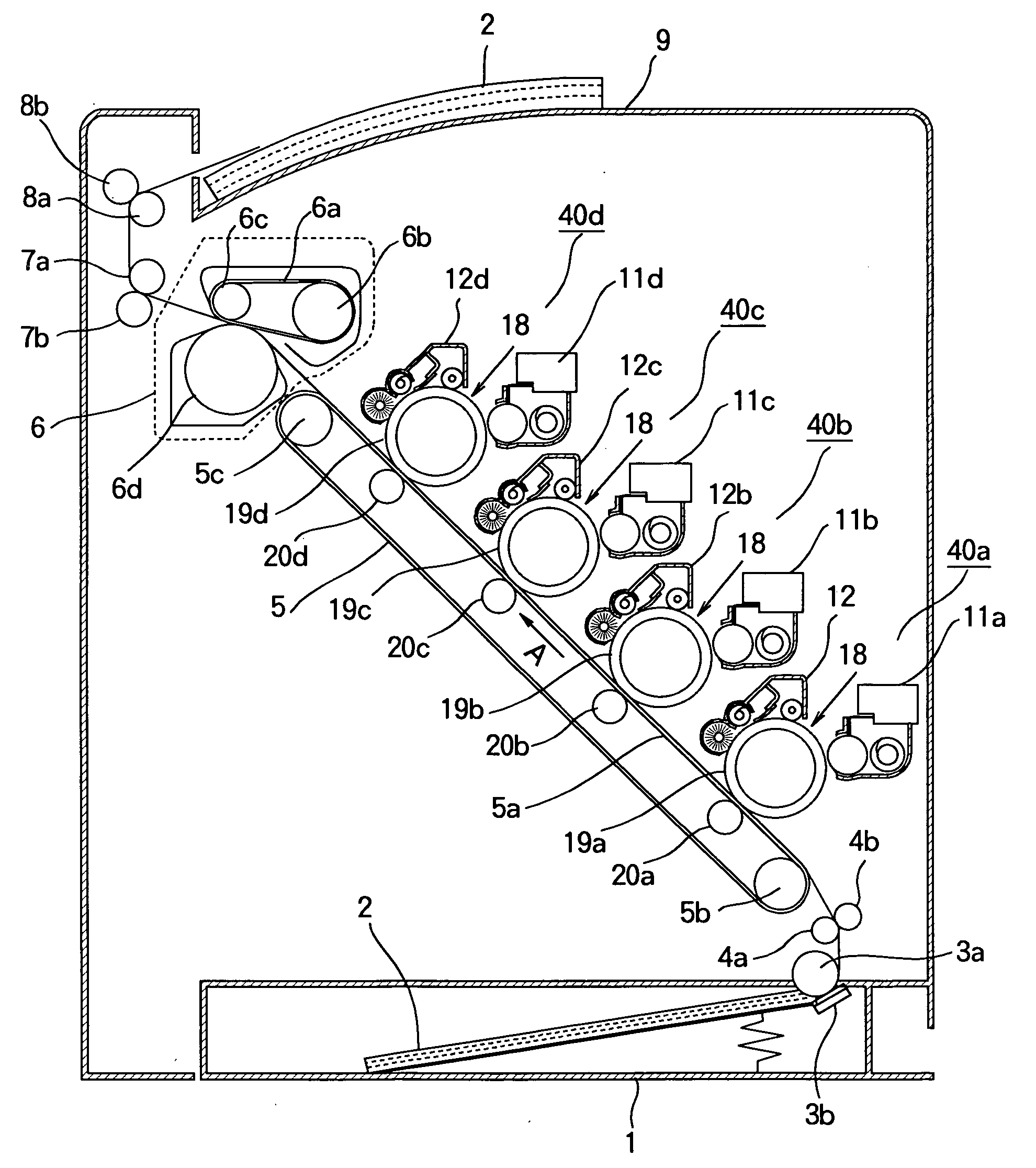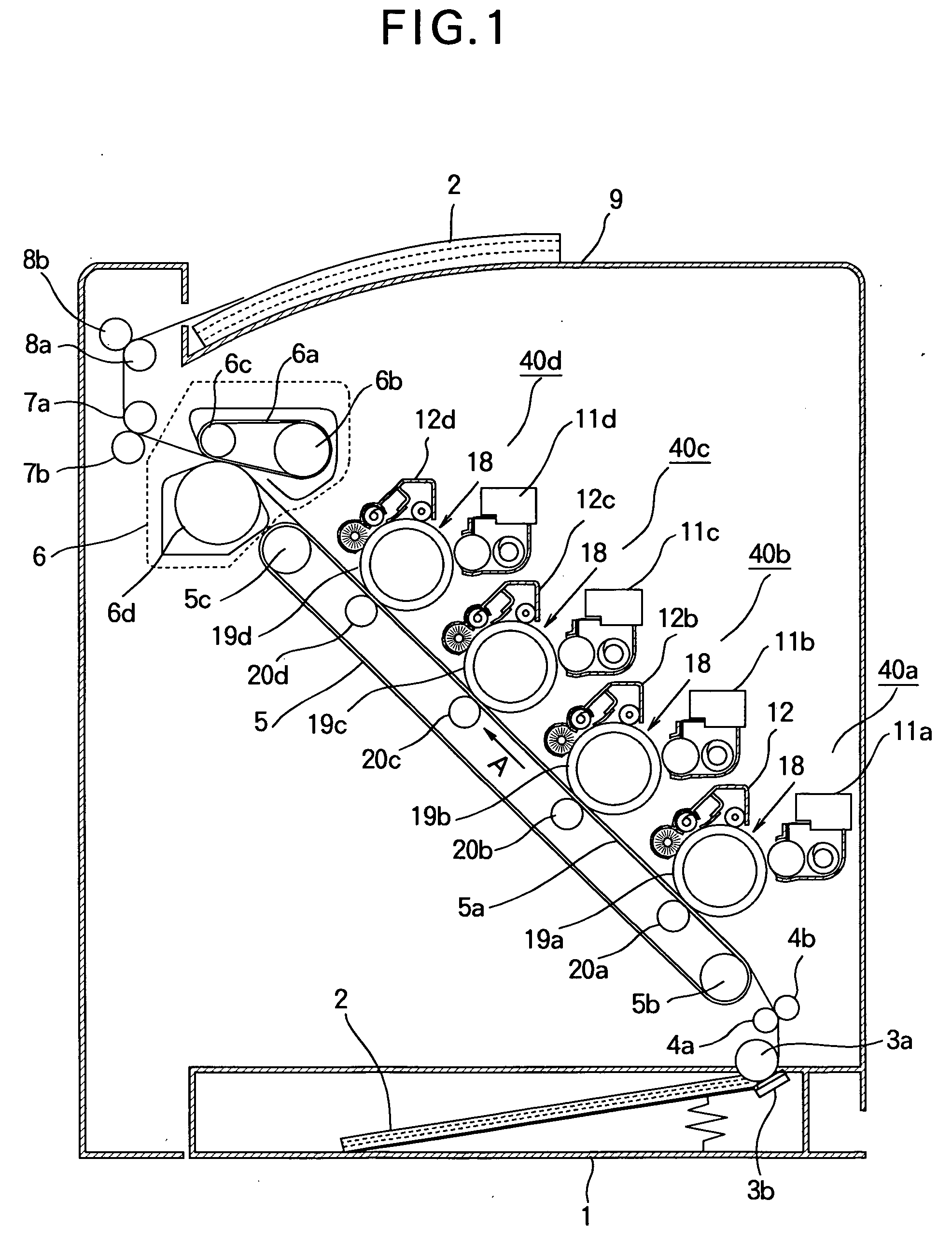Image forming apparatus
- Summary
- Abstract
- Description
- Claims
- Application Information
AI Technical Summary
Benefits of technology
Problems solved by technology
Method used
Image
Examples
first embodiment
[0034]FIG. 1 illustrates an image forming apparatus according to the present invention. Image forming sections 40a-40d are aligned along a transfer belt 5a of a transfer unit 5, and form yellow, magenta, cyan, and black images, respectively. The image forming sections 40a-40d are aligned from a lower right corner to an upper left corner in such a way that the preceding one of adjacent ones is above the following one of the adjacent ones. The image forming sections 40a-40d include developing units 11a-11d and cleaning units 12a-12d, respectively. Developing rollers of the developing units 11a-11d are in pressure contact with the photoconductive bodies 19a-19d, respectively. The cleaning units 12a-12d abut the photoconductive bodies 19a-19d, respectively, to collect residual toner from the photoconductive bodies 19a-19d.
[0035] A medium tray 1 holds a stack of medium 2 therein. A separator roller 3a cooperates with a separator tongue 3b to separate a top page from the stack of medium ...
second embodiment
[0049]FIG. 8 is a side view illustrating the cleaning unit and the developing unit according to a second embodiment. The toner transporting member 24 and a mounting portion 26c that accommodates a solid lubricant 31 are disposed to surround the cleaning brush 22. The mounting portion 26c is downstream of the toner transporting member 24 with respect to a direction shown by arrow G, i.e., the direction of rotation of the cleaning brush 22. The mounting portion 26c accommodates the solid lubricant 31 and a resilient member 30 therein. The resilient member 30 urges the lubricant 31 against the tips of the bristles of the cleaning brush 22. The lubricant 31 is made by first melting a lubrication oil additive that contains zinc stearate as a major component, and then cooling it to a solid state. The rest of the configuration of the second embodiment is the same as that of the first embodiment and the description thereof is omitted.
[0050]FIG. 9 illustrates a pertinent portion of a cleani...
third embodiment
[0052]FIG. 10 is a side view illustrating a cleaning unit and a developing unit according to a third embodiment. Referring to FIG. 10, a flicker 26b is located downstream with respect to the rotation of the cleaning brush 22 at a point at which a cleaning brush 22 engages a photoconductive body 19. The flicker 26b is provided on a part of a cover 26, and extends in its longitudinal direction, which is parallel to the rotational axis of the cleaning brush 22. The length of the flicker 26b is the same as or longer than the cleaning brush 22. The flicker 26b is positioned so that when the cleaning brush 22 rotates, the flicker 26b can engage the tip portions of the bristles of the cleaning brush 22 or enter into the bristles. When the cleaning brush 22 rotates, the flicker 26b interferes with the tip partitions of the bristles, causing the bristles to first flex resiliently and then releasing the bristles so that the bristles vibrate to shake the toner particles off the bristles. The r...
PUM
 Login to View More
Login to View More Abstract
Description
Claims
Application Information
 Login to View More
Login to View More - R&D
- Intellectual Property
- Life Sciences
- Materials
- Tech Scout
- Unparalleled Data Quality
- Higher Quality Content
- 60% Fewer Hallucinations
Browse by: Latest US Patents, China's latest patents, Technical Efficacy Thesaurus, Application Domain, Technology Topic, Popular Technical Reports.
© 2025 PatSnap. All rights reserved.Legal|Privacy policy|Modern Slavery Act Transparency Statement|Sitemap|About US| Contact US: help@patsnap.com



